| HORSES |
YEAR: 2002
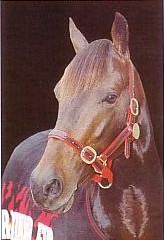 |
Courage Under Fire's contribution to harness racing was far greater than 41 career wins, a string of feature race titles and almost $1.5 million in stakes.
Affectionately known as "Mighty Mouse" in Australia and "The Pocket Rocket" in New Zealand, Courage Under Fire alone took harness racing to the wider sporting world with his 24-race winning streak. It was common-place to see some big thoroughbred names making a special trip to the trots just to watch the pint-sized people-puller strut his stuff. Cricketing heroes Mark Waugh and Ricky Ponting were also huge fans of the pacer.
Courage Under Fire first captured my imagination on Christchurch Show Day in November, 1998, when he overcame a torrid run to beat NZ's best 3-year-olds. It was a performance of a champion. In the nine months that followed, the son of In The Pocket proved himself one of, if not the best 3-year-old Australasia has seen with a record-breaking six Derby wins.
The best win of his career came at Moonee Valley on July 10, 1999. It was the Australian Derby and local star Shakamaker was at the top of his game. What was supposed to be a thrilling contest turned into one of the most emphatic and memorable wins in the history of Moonee Valley. In a stunning display of sustained speed, Courage Under Fire simply ran his rivals ragged. His 1:56.5 mile rate for 2540m not only destroyed the track record, but also bettered the world mark.
Another of his stellar performances came at the Gold Coast just weeks before the Australian Derby, when the colt came as close as I have ever seen to a horse winning by the length of the straight. The official margin was 48.75m and the time for the mile a sizzling 1:54.9. Racecaller Dan Mielicki superbly captured the moment of Courage Under Fire's first defeat - at Moonee Valley in January 2000 - with the words: "The world must be ending."
As dramatic as it sounded, Mielicki's call was closer to the mark than even he realised at the time. Life went on, but Courage Under Fire was never quite the same. Gone was that invincibility, that intimidating presence that terrorised his rivals. Trainer Bruce Negus handed the reins to Brian Hancock in a headline-grabbing stable change. Hancock was always in a no-win situation. Everbody expected Courage Under Fire to dominate the Grand Curcuit and nothing short of that would surffice. The truth is, Courage Under Fire, by the lofty standards of his youth, was a disappointment in the big league.
But, as Hancock said this week, if you forget his deeds at two and three and just judged him on his Grand Curcuit form, he "did a damn good job." He won three Grand Curcuit events, contested three Inter-Dominion finals and won six Inter heats. Racing against horses that dwarfed him, every race as an older horse was a war for Courage Under Fire. He was one of the most appropriately named horses we have ever seen.
My memories of Courage Under Fire will be as much about the huge crowds that surrounded his stall for a glimpse, as they will for his fantastic deeds on the track. He was a people-pleaser and I was pleased to have followed his career from start to finish. Farewell, little fella.
Credit: Adam Hamilton writing in HRWeekly 18Sep02
YEAR: 2002
MONKEY KING - Bargain Buy
MONKEY KING(2002) $20,000 39 wins $3.48m
$20,000 might not seem like much of a bargain but balance it against stakes won and it looks a steal. What is more, just one more bid around the ring and Steven Reid and Robert Famularo's dream would have been someone else's triumph.
After looking a smart but not a great pacer, one night 'The Monkey' produced a phenomenal last quarter in a race at Addington, and from then on it was a trail of riches. It took him a while to nail a New Zealand Cup with his pioneering of the modern 'bike' in this country but in the end he did it all.
Steven Reid later recalled that $20,000 was the last bid. Robert had that as his limit(a fairly sensible one in those years) and one more call from the rival buyer would have nailed one of the greatest earners of modern times. I wonder if someone still wakes up at night thinking about that.
Credit: David McCarthy writing in Harnessed May 2016
YEAR: 2002
BIONIC STAR
"She was as game as any horse I ever sat behind." Those were the sentiments of Bob Cameron last week upon learning that grand race and broodmare Bionic Star had died aged 26. Cameron was the regular reinsman of Bionic Star, who recorded eight wins and seven seconds from just 23 starts in a career restricted by unsoundness. "She had the ups and downs due to tendon problems, but she certainly had plenty of ability on the rest." A race that remains vivid for Cameron was the Waikouaiti Cup, a fourth consecutive win in the Spring of 1979.
Bionic Star was bred to be royalty, being by Bachelor Hanover from Broodmare of the Year, Adio Star, dam of 10 winners including the Derby winners Bachelor Star, Main Adios, Main Star and Game Adios. She didn't disappoint at stud either, her second foal being the quite outstanding racemare Bionic Chance, who proved more than a match for the colts on many occasions. Bionic Chance is the only filly to have won the NZ Sires' Stakes 2YO Final and almost undid Race Ruler's Triple Crown aspirations in the NZ Derby. The following season she showed an astonishing display of speed to win the NZ Standardbred Breeders Stakes over Gina Rosa, Frangelico, Michele Bromac and Victoria Star. Also among Bionic Star's first three foals were Bionic Raider(6 wins) and Pacelbel(4 wins), while her remaining seven foals all qualified, with six to race and three winning.
Credit: Frank Marrion writing in HRWeekly 20Mar02
YEAR: 1999
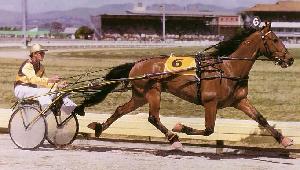 |
No Response, the 1978/79 NZ Harness Horse of the Year, died last week. No Response, who turned 28 last Sunday, was in retirement on the property at Kerrytown where he was trained by Richard Brosnan for breeder Fred Black, of St Kilda and formerly Pleasant Point. The property is leased by Brosnan to David Gaffaney.
An electrifying run from the rear of the field at the 600m carried No Response to a two-length win in the Inter-Dominion Trotting Championship Grand Final at Addington in 1979. The Hodgen's Surprise-Cordsworth gelding had won his heats on the first two nights. He won the NZ Trotting Championship on the fourth day to post 10 successive wins and 12 fron 16 starts as a 7-year-old.
His achievments earned him the Horse of the Year title. His other major wins that season were the Benson and Hedges Stakes and NZ National Trot at Alexandra Park. No Response did not win in six starts as a 8-year-old but he came back at nine to win the J Rowe Memorial Cup at Alexandra Park, the NZ Trotting Championship and three other races.
No Response began his racing career at Waikouaiti in October 1977 as a 6-year-old when unplaced. He was then trained by Black and won at his next start at Orari. He won his next start for Black at Washdyke and then transferred to Brosnan, who was his regular driver. "I remember most of his wins, but one of his best efforts was his win in a free-for-all at Timaru before he went to Australia in 1981," said Black, who is 89. He won a heat of the Australasian Trotting Championship at Moonee Valley in 1981 from five starts in Australia.
He was retired after the Rowe Cup with a record of 24 wins and 21 placings from 60 starts for $135,128 in stakes.
Black won four races with Cordsworth (by speedy trotter Ripcord), the dam of No Response. He had been given First Axworth, the dam of Cordsworth, by a friend, Dave Hansen of Palmerston North.
Credit: Taylor Strong writing in HRWeekly 11Aug99
YEAR: 1998
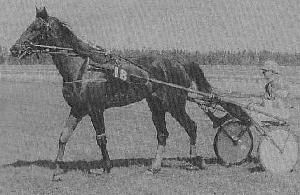 |
Waipounamu, winner of 17 races trotting in the 1970s, has been put down at the age of 29.
"The winters were getting harder on him with his bad arthritis," Bill Sutherland, a son of Waipounamu's late owner Gordon Sutherland, said. Waipounamu had been running at Riverdale, where Gordon Sutherland farmed.
"He (Waipounamu) was a bit of a character. 'Old Jack', as we called him, was still jumping the odd gate to get into a better paddock until a couple of years ago." The jumping habit was a characteristic of Waipounamu when he was in the Duntroon stable of the late Stewart Sutherland, a brother of Gordon.
The Aksarben-Tataus gelding, bred by Stewart, was 11 when he recorded his final win, the 1980 Canterbury Park Trotting Cup with Jack Smolenski the driver. Inter-Dominion winners Hano Direct and No Response were among the beaten division.
Waipounamu had his first win as a 4-year-old at the 50th jubilee meeting of the Wyndham Trotting Club in March, 1973. He won each season he raced, except as a 9-year-old. He was retired in 1980 with a record of 203 starts for 17 wins and 73 placings for $72,075 in stakes.
His other good wins were the NZ National Trot at Alexandra Park, Ordeal Cup at Addington and the Banks Peninsula Cup. He ran second to Ritch Hill in the 1978 Rowe Cup in Auckland and he filled a similar placing behind Maori's Idol in a heat on the Inter-Dominion at Moonee Valley in 1978.
Credit: NZ HRWeekly 17Jun98
YEAR: 1996
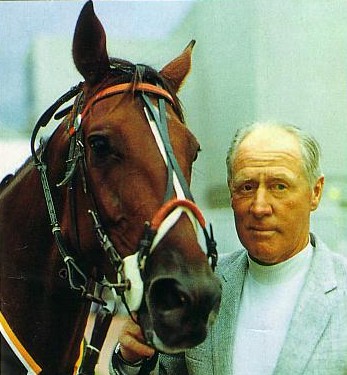 |
| Derek Jones & Blossom Lady |
There would be few Addington personalities in the last 50 years who have attracted such favour and adulation as Blossom Lady. In this context, Johnny Globe probably reigns supreme, with Blossom Lady a close second, ahead of Lordship and Lord Module.
The retirement at the weekend of New Zealand's greatest racemare is of no surprise: it has been on hold for two and a half years!
Lesser competitors would have given up the battle, but the skills of trainer Derek Jones coupled with an indomitable spirit gave Blossom Lady a long life at the top. On the eve of her 156th start, she was still working as well as ever. But when a leg injury she has tolerated since the Brisbane Inter-Dominions in 1993 made another visit, Jones decided the show was over.
"Derek told us that he would never forgive himself if he had raced her last Saturday night and something had happened to her," said Ralph Kermode, the manager of the Polly Syndicate which raced the million dollar mare. "We have no complaints. It has been something we have anticipated for some time, certainly this season. After she ran the fastest two miles of her career at the Cup meeting and the fastest mile, we thought we might get back to Melbourne, where she won two Hunter Cups. But we have had a fantastic run, with marvellous memories. Derek has done a marvellous job, swimming her a lot, rubbing her leg every day," he said.
Prepared for a start by Stephen Doody, Blossom Lady went on to win 43 races - most of them in the hands of regular driver Anthony Butt - and earn $1,334,800 from 155 starts.
Her major wins were the 1992 NZ Cup and NZ Free-For-All, the 1991 Easter Cup, two Hunter Cups, six Inter-Dominion heats, the Monsanto Free-For-All, three NZ Standardbred Breeders Stakes, an Inter-Dominion consolation race and the Ashburton Cup. 'Bloss' won 35 races in NZ and eight in Australia. Eight of her NZ wins were sub 2:00 - 1:56 (1m), 1:58.9 (2000 mob), 1:58.6 (2400 mob), 1: 59.1, 1:57, 1:57.3, 1:58.7, 1:56.8 and 1:58.9 (all 2000m mobile).
She was much travelled and was renowned for her need to absorb an enormous amount of work. Her racing was characterised by a willingness to look the enemy in the eye whenever there was a softening of the pace.
"She was the sort of horse an owner dreams of having," said Kermode. "She was so honest. She would never run a bad race. She had bad luck, but you'd always know she would perform. In many races, she would take to race to the opposition, although it did not always pay off. The most spine-tingling moment for me was in the Easter Cup that Chokin won when she led for the last mile and took off down the back straight, and my only disappointment was that she didn't meet up more with Franco Ice who had a similar style of racing," he said.
Credit: Mike Grainger writing in HRWeekly 10Jan96
YEAR: 1993
SCUSE ME - Classic Winner Producing Mare
Scuse Me(1993 BGs Bunny-Super Smooth), USA family of Nora by Glencoe; 1:53.5, $126,841, 8 wins; 15 foals, 12 to race, 12 winners. Breeder and breeder of all her foals: Charles(CJ) Roberts.
Scuse Me is without doubt the mare of the moment - the hottest breeding proposition in NZ. Over the past couple of decades, the immediate family includes horses of the calibre of Christen Me, Adore Me, Have Faith In Me, Dream About Me, Imagine Me, Hands Christian to name a few. Woodlands Stud supremo Charles Roberts is prominent as breeder of Scuse Me as well as being involved in the breeding/ownership of a number of the family offspring.
Her sire, BGs Bunny, only stood the one season in NZ at Woodlands Stud serving 245 mares(161 live foals) before dying from a heart attack in September 1993. A grandson of Meadow Skipper and a top siring son of Albatross, BGs Bunny won 12 of his 26 two/three starts. He sired over 1,000 winners in USA with a number of his colts standing at stud in NZ(ill-fated Butler BG who also died from a heart attack in September 1993; McKinzie Almahurst; Allwin Steady; power Bunny). His broodmare sire record ranks him highly amongst the all-time greats - Precious Bunny, Tooter Scooter, Armbro Operative, Cams Card Shark, The Falcon Strike and stallions that stood in NZ at one time in WRH, OK Bye and Cams Trickster. BGs Bunny's major NZ credits all flow from Scuse Me.
Scuse Me's dam Super Smooth, unraced dam of 15 foals(five by embryo transplant, two to race both winners), 7 to race for 7 winners, four of whom won in NZ before having successful Australian careers. Other than Scuse Me, her progeny included Tricky Woman(3 wins, 1:56.2 at Winton), Vicalo(3 NZ wins/5 AUS wins, 4 wins at Albion Park), Il Casino(winner in NZ/14 WA wins, four at Gloucester Park), Supabet(4nZ wins/10 Qld wins, 8 at Albion Park, 1:53.8). Fallacy mare Gold Heritage's (granddam of Super Smooth), daughter Remit left dual Australian Broodmare of the Year Fiscal Miss(dam of Whitbys Miss Penny [da of Ima Spicey Lombo], Ace of Whitby, Whitby Timer, Whitbys Merit(dam of Montana Anna)-the Whitby clan.
Whilst known as the USA family of Nora by Glencoe, from a NZ perspective this is the family of Childe Harold mare Moonbeam(foaled in NSW in 1889) whose third dam is Nora. Moonbeam's dam Gracie was exported in foal to Australia from North America. Moonbeam left Don Cleve (successful sire/ damsire of AK Cup winner Blue Mountain King), breeding on through her filly Daybreak, winner of Henry Mace Memorial and Recovery Hcp at Addington. It was from Daybreak's filly Daisy Pointer that latter day NZ winners from this family eventuate(Daisy Scott to Dasy Gold to Gold Heritage). Major descendants apart from those tracing to Scuse Me include Quincey, Sir Joe, Pointer Hanover, Josephine Bret, Onedin Supreme, Bondy, Maximan.
The first foal of Super Smooth, Scuse Me won 8 of her 25 starts. Her race career commenced as a late 2yo with a second placing from 2 starts. At three, she was third in her second start in the Ladyship Stakes (won by Kates First), before recording her first win in a fillies maiden at Addington. She followed this with a forth in NZSS 3yof before winning three races at Alexandra Park including the GN Oaks and two Hydroflow Fillies heats. A win at Cambridge and then at Addington concluded her wins for the season(6) before finishing fifth in the NZ Oaks and seventh in the Hydroflow final. At four, Scuse Me, commenced with a win at Cambridge in an Elliott Futurity Stakes heat, several placings(thirds in Elliott Futurity final, GN Breeders 4yo Stakes) prior to her major CV credit, the Taylor Mile. In this she established the NZR of 1:53.5 for a mile, still an Alexandra Park mile record and equal fastest MR at Auckland(with Besotted, 1:53.5, 1700m). A fourth a week later in the Messenger was her final dividend-bearing place. Scuse Me has to date had 12 foals to race for 12 winners. She achieved breeding glory being named 2013 Broodmare of Year and receiving NZSBA Broodmare of Excellence Award.
Scuse Me's male progeny include:
Have Faith In Me, 2014/5 3yo colt/gelding pacer of year(7 victories in 11 3yo starts) is the first 3yo to achieve four Group One victories in a season: NZSS 3yoc(1:53.2, 1950), GN & NZ Derbies, Harness Jewels(1:52.5, 1 mile) together with the Flying Stakes and the listed 3yo Yearling Sales Series final. At four, he won first up in the Group Three Junior FFA(sponsored by Fahey Fence Hire) on NZ Cup Day, arrogantly winning in near NZ record time of 3:07.6/1:56.0(2600m). His performance to finish third in the Franklin Cup after conservatively losing 100m at the start and running unofficial sectionals of 2:53.7(last 1½m), last mile in 1:54.1, half in 55.1 and quarter in 27.0, to go down by 2¾l in a 2:00 mile rate(2700m stand)was exceptional. The heir apparent in waiting then maintained his faultless group One records when recording his fifth Group One success in the second running of the 2015 Auckland Cup on New Years Eve(2014/5 season Cup run in March 2015 won by Christen Me). Starting from the unruly position, he began well and toughed out the 3200m journey to record his biggest win to date. At the beginning of January 2016, his record stood at 18:10-3-1, $712,279.
Megabucks, winner of 5 from 17 starts in NZ(Te Awamutu Cup, Alexandra Park 4 wins). In North America, winner of 7 recording 1:49.3US(Colonial Downs).
Toledo, seven-race winner in NZ with 4 as a 3yo(Alexandra Park[3], Cambridge), 2 at four(Alexandra Park, NZYSS Aged Pace at Kaikoura) and 1 victory at five at Alexandra Park before his export to Australia. He won his first start at Bathurst, his only placing in 7 starts over two years in Australia.
It is however Scuse Me's fillies that have taken prominence including:
Adore Me, outstanding champion filly and race mare, retired winner of 26 from 36 starts, $1.6m, 1:47.7(p3, 1:52.4), 12 Group Ones, 5 Group Two, 3 Group Three victories and placed in seven Group Ones(unplaced on only three occasions. At three, won 11 of 12 starts including the Ladyship Stakes, NZSS-3f(heat & final), GN & NZ Oaks, Nevele R Fillies(heat & final), Jewels-3f, plus additional wins at Auckland and Addington(2) with her only defeat being second in GN Derby after drawing the outside of the second row. She was the 3yo filly of her year. At four, she was the winner of 8 of 12 starts including the Junior FFA on Cup Day, GN Breeders Stakes, Queen of Hearts, Premier Mares Championship, NZ Standardbred Breeders Stakes, the Easter Cup, 4yo Jewels and an additional win at Addington plus seconds in the AK Cup, NSW Ladyship Mile and third in the Taylor Mile. At five, Adore M was the winner of 7 from 12 starts the NZ Cup, Ashburton Flying Stakes, GN Breeders Stakes, Queen of Hearts, Waikato Flying Mile(NZ mares mile record 1:51.6), Brian Hancock Cup, Ladyship Mile(Australasian record 1:47.7); 2nd NZFFA, Ak Cup and third in the Victoria Cup. She retired after fracturing a sesamoid bone when faltering briefly in the run home during her close second to her close relation Christen Me in the 2015 Auckland Cup. Adore Me was Aged Mare of the Year as both a 4 & 5yo.
Imagine Me, fine race mare, winner of 9 including 6 at three. She won her first 2 starts at Ashburton and Addington, followed by NZSS 3yof heat at Addington(3rd in the final), Nevele R Fillies heat at Forbury Park(2nd & 3rd in the Addington heats, 3rd in the final), AUS Breeders Crown heat at Addington-walkover; 5th in the semi-final and 3rd final)plus second in the 3yof Jewels and thirds in the Ladyship Stakes, GN & NZ Oaks. At four she was a winner at Alexandra Park on three occasions including the NI Breeders Stakes and third in the 4yo mares Jewels. Imagine Me had four 5yo starts for four fourths all at Alexandra Park including the GN Breeders Stakes and the Queen of Hearts before being retired (dam of a qualifier).
La Filou, Alexandra Park winner, dam of three winners including The Dip, 14 AUS wins(VIC VHRSC(MHRC) Cup at three, TAS Guineas.
Splendid Dreams, sub two-minute winner at first start(3yo), subsequently winning 2 of 6 starts. Proving to be a sensational broodmare carrying on from her mother Scuse Me, dam of:
. Christen Me, $2m+, 29 wins, 1:49.1, two-time Australasian Grand Circuit champion, multiple group winner(Hondo Grattan Sprint, Chariots of Fire, Superstars, Taylor Mile, Messenger, 4yo Jewels Emerald, New Briughton, Hunter, Bendigo, Victoria, Auckland and Easter Cups, Canterbury Classic, National Hcp, Maurice Holmes Vase twice, NZFFA, & Miracle Mile) plus Group One placed seconds in the Miracle Mile, Ballarat & Cranbourne Cups and thirds in the NZ & Victoria Cups.
Hands Christian, Easter Cup, Cambridge Futurity, International Cargo Express FFA, Paleface Adios Sprint, seconds in the NZSS & the 3yo Jewels and third in the 3yo NZYSS, 1:52.5
Dream About Me, 2014/5 NZ 2yo filly Pacer of the Year, unbeaten in 5 NZ starts at 2 and 3 Australian starts; Delightful Lady Classic 2f, 2f NZSS(p2, 1:54.9), Harness Jewels(NZ Record 1:53.3) and winner in Australiaof 2f Breeders Crown(1:57).
Splendid Deal, unraced dam of:
. Maxim, 5 wins including NZSS 2c, and VIC Derby heat & final.
. Splendour, 8 wins including Gold Coast Oaks(2nd Queensland Oaks), Nevele R heat.
Minor winners from Scuse Me - Coca Vicola(winner): Pardin Me(NZ winner, 10 WA/1 GP): Abide With Me(4 wins): Idolise Me(3 NZ wins, 1 Australia): Ohoka Jett(winner)
Credit: Peter Craig writing in Harnessed Feb 2016
YEAR: 1993
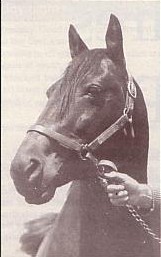 |
Successful racehorse and sire Good Chase was humanely put down the Thursday before last at Rosewood Stud, Annat, age having finally caught up with him. "He was rising 29," said Dennis Watson, who drove the good son of Light Brigade, owned and trained by his father, the late Oscar Watson, to his 9 NZ wins. "He served a couple of mares this past year and got one of them in foal, but just recently he had been having difficulty breathing and getting up on his feet."
From a prolific winner-producing line nurtured over the years by the Watsons and widely recognised as the "Rosewood family", Good Chase was from the unraced U Scott-Rosewood mare Torlesse. Like Rosewood before her, Torlesse left a string of winners.
Rosewood, by the Jack Potts horse Gamble (winner of the 1934 NZ Derby and second to Lucky Jack in the 1937 NZ Cup), was unraced. She was one of only two filly foals bred by Oscar Watson from Peggywood, an unraced non-standardbred daughter of 1909 and 1910 NZ Cups winner Wildwood Junior. Lady Ngaio, Rosewood's full-sister, was trained at Yaldhurst by Basil Lynskey for Oscar Watson to win six races in the 1940s, but died before she could be bred from.
Oscar offered Good Chase as a yearling in the 1964 National Sale. The Reid brothers, Leo and Robert, of Waiuku, were about to buy him on the recommendation of the late Jack Shaw - a renowned judge of horseflesh - but shied off when Shaw detected a filling in one of the colts legs. The Reids instead paid 1000 guineas for the Garrison Hanover-Miranda Scott filly, which, as Miranda Bay, founded them an outstanding line of winners headed by Luxury Liner ($1.7m) and Christopher Vance ($1.5m).
When bidding ceased at 950 guineas on Good Chase, Watson, who wanted at least 1000 guineas for him, took him home. Good Chase became the top youngster of his day, winning eight races at two and three, including the Welcome Stakes and NZ Derby, then one of two starts at four, the National Handicap. At this point, with earnings of $13,330, Good Chase was secured in a lease arrangement by prominent American breeder-owner Allan Leavitt.
In America, Good Chase measured up to the best. He was placed in all three races of the 1970 International Pace Series at Yonkers Raceway, while his victories included the Provincial Cup in Canada and Dan Patch Aged Pace in New York. An injury to a leg, that necessitated an operation, forced Good Chase's retirement, and - with a career record of 37 starts for 25 wins, five seconds and two thirds - he returned to NZ to stand for Dennis and brother John with a full book in 1973.
Before he had left NZ for the States, Good Chase had served 20 odd mares, from which there were 11 winners. These include Willie Win (NZ Derby), Hardcraft (Welcome Stakes)and other excellent performers in Big Chase (Cambridge Gold Cup), Free Chase (placed third in the NZ Derby)and James Hadley (a big winner in America). Not able to duplicate that initial success with his first small crop, Good Chase quickly fell from favour, and over the past decade served very few mares. His daughters have bred on, among them being Millie's Choice, dam of the outstanding duo Smooth Millie and Millie's Brother.
"Good Chase was like a Rolls Royce to drive," recalls Dennis. "He actually died on the anniversary of Dad's death, which we did not realise until after he was put down. It's as if the old fellow might have him back again."
Credit: Ron Bisman writing in HRWeekly 26May93
YEAR: 1993
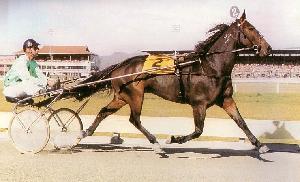 |
The death on a Hororata farm last week of Scotch Tar rekindled memories of a trotter ranked with the all-time greats. For the past three years, Scotch Tar has been cared for by Alf Phillips, and he died suddenly , aged 20.
Scotch Tar won 29 races - two Dominion Handicaps, the Dunedin Cup, the Worthy Queen Handicap, two NZ Trotting Free-For-Alls, the Ordeal Cup, a heat of the Inter-Dominions, and two Benson and Hedges Challenge Stakes. He had a versatile career, racing against pacers, setting records, and putting up some huge performances against such stars of the day as No Response, Stormy Morn, About Now, Game Way, Even Speed and Thriller Dee.
He as trained throughout his career by 'Slim' Dykman, now living in Australia, who handled him in 15 of his wins. Robert Cameron drove him in his first 10, and Peter Wolfenden in the others. Cameron was his first trainer, having bought the Tarport Coulter-Scotch Penny colt as a yearling from Sir Roy McKenzie. Scotch Penny is notable for her offspring in the case of Scotch Tar, and also for being the galloping prompter in a time trial by Garcon Roux at Hutt Park but being too slow to keep up.
The best Scotch Tar could do for Cameron in his early training was making a quarter in 36. "I wasn't getting on with him, so I put him in a dispersal sale at Ashburton and Slim bought him for $1000," said Cameron. Dykman gelded him, and the pair soon struck a chord, and Cameron was in the cart when Scotch Tar made a winning debut at Methven in September, 1977. The combination won five races that season, and five the next, including the Dominion Handicap as a 5-year-old from Spartan Prince and Framalda in NZ record time of 4:11.6 for 3200m.
Cameron and Dykman had a parting of the ways at this time, after Dykman questioned the manner in which Cameron had driven the horse. "Scotch Tar was a great competitor, but I have always said that David Moss is a better horse. He is a nice driving horse, settles and doesn't pull. But Scotch Tar was tough, and got better as he went along. In the Dominion, he was on one rein, and was beaten on the corner. But he kept trotting, kept going, and wasn't beaten in the end. And he had remarkable speed. When he raced in the Free-For-All over 2000 metres at the Cup meeting against Hands Down, he led out and went over his first quarter in 27 (26.8 in fact)," he said. In that race, Scotch Tar led for the first 1600 metres, which took him 1:57.4, until he folded over the last 200 metres.
Scotch Tar also won the Dominion Handicap as a 7-year-old from Stormy Morn and Game Way. He won once from nine starts as an 8-year-old, and he defeated Sir Castleton and Dryden Lobell in one of his two wins from seven starts as a 9-year-old.
Scotch Tar's last public appearance was at the Ashburton Trotting Club's centennial meeting in 1990. Kevin McRae prepared him for the meeting and was astonished to find that after just two weeks he covered a half in 1:05. "I'm pretty lucky if a good maiden can run a half on my track in three," he said. Once the centennial was over, Scotch Tar's final resting place was at Hororata, where his company were young horses of similar calling.
Credit: Mike Grainger writing in HRWeekly 8Dec93
YEAR: 1992
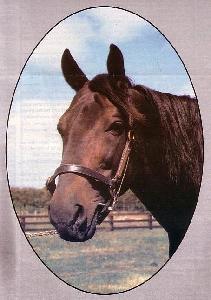 |
Vance Hanover who died suddenly aged 17 at Vance Lodge in South Auckland on Saturday morning at the peak of his mercurial career was a sensational sire. There was no other way to describe him.
The nuggety, unraced stallion - the first son of world champion pacer and sire Albatross to be made available to NZ breeders - rocketed to a pre-eminence that could one day see him heralded as the Hambletonian 10 or the Meadow Skipper of the standardbred industry in this country.
Vance Hanover sired winners from mares of the lowliest credentials to forge himself an initial popularity that led him to attracting record numbers of matrons, eventually including the most fashionable. He shattered all previous records for mares covered, local individual winners and wins and seasonal stakemoney won by his stock. With 10 crops on the tracks, he is well on his way to dominating the sires' premiership for the fifth straight season. The quality of his representatives, who will no doubt dominate our racing for some seasons to come, embraced speed, stamina, versatility and durability, while both his sons and daughters demonstrated these assets and there were already signs that his sons and daughters would breed on successfully.
Helen Andrews, wife of Vance Lodge co-director Eric Andrews, found Vance Hanover dead in his paddock around 8.30 on Saturday morning, some 45 minutes after he had served a mare. "He had served all but three of the 115 mares booked to him here, while down at Templeton, where Kevin Williams has been inseminating South Island mares booked to him, there were about 20 to go of some 120," said Vance Lodge studmaster Fraser Kirk.
Williams confirmed that six mares were inseminated with Saturday's final collection from Vance Hanover. "There will only be about 20 mares miss out, although there are a few mares who have only been inseminated once that we have our fingers crossed for, and these include some good ones, like Bella Regazza, the dam of Giovanetto," said Williams. "We had 70 positives, and I think there will be about 80 booked here get in foal."
Vance Hanover was insured by Andrews and Graham Brown, co-directors of Vance Lodge. Said Kirk: "I thought he would live until he was 30. He was unraced and so strong, and his legs were unmarked. What the future holds now I just don't know." Said Williams: "It is such a shock. We had it teed up beautifully, allowing more than 100 South Island breeders access to him, and everything was working like clockwork. At least we pioneered this semen transportation in New Zealand, and proved that, beyond doubt, it is both viable and successful."
Vance Hanover was the 1975 foal of the Best Of All mare Valentine Hanover, who was from a prized Tar Heel mare Valentine Day. On this good breeding and his own impressive conformation, famed Hanover Shoe Farms in Pennsylvania sold him for $85,000 as a yearling. As an un-raced 2-year-old, he cracked a sesamoid. His trainer, Vernon Dancer, wanted to bring him back into work when the fracture mended, but Vance Hanover's owner indicated she didn't want the horse to race.
He was purchased for New Zealand by Aucklander Noel Taylor and Southland breeding expert Norm Pierce, who first leased him and then, a year later, sold him to the late Dave Jessop. Offered first in 1979 by Jessop at the bargain fee of $400 - to attract as many mares as possible and set his new Placid Lodge base at Waiuku on firm footing - Vance Hanover attracted big numbers of mares, albeit very few of them that could be described as other than nondescript.
While Vance Hanover's earliest sons and daughters showed excellent potential (he was leading sire of 2-year-olds with his secod crop in 1983/84), Jessop kept the fee down at $500. In 1984 he got an amazing total of 402 mares to him - definitely a NZ record and possibly a world best. At this point, Jessop, in ill health, reluctantly let Vance Hanover go to a consortium headed by North Shore accountant Graham Brown, in a deal that put the stallion's value at something close to $1m.
Vance Hanover moved a few kilometres up the road to the newly established Vance Lodge at Waiau Pa on the southern shores of the Manukau Harbour. His fee was hiked to $2000, and, with Trevor Payne his studmaster, his book there in 1985 was 347 mares. It was in this year that, for the first time, a good number of class matrons met up with him, his book including some 50 mares sent from the South Island. To Vance Hanover's everlasting credit, from the many mares booked to him in his earliest years of duty who had not produced anything of account, even to fashionable sires, he achieved an excellent strike-rate of winners to foals.
Vance Hanover was in 1986 re-negotiated to stand at Ivan Pavlovich's plush new Great Northern Bloodstock nursery at Te Aroha, in a deal that put his value close to $2m. With his fee eventually set at $6000, he covered 130 mares there in 1986, after which Pavlovich decided to let him go, by popular demand, to be available to South Island mares at his newly-leased and refurbished stud, Poplar Lane Lodge, Ashburton. At Poplar Lane in 1987, Vance Hanover, at a basic $6000 plus GST, took care of 243 bookings.
In topping the sires' list in 1987/88 for the first time, with only six crops on the tracks (and these virtually all in North Island stables), Vance Hanover set new figures for sire earnings in a season of $1,323,129 and a record number of individual winners during the term - 66. He had 139 starters for the season, who won 156 races in total, including 96 at Alexandra Park. Vance Hanover had burst into the top spot as a result of a remarkable season for his progeny across the spectrum of age-groups and classes. In 1988/89, Vance Hanover eclipsed his previous record total with two months of the term to run, and by season's end his representatives had amassed a whopping $1.62m. His 87 individual winners was another record, and also their 190 wins. In this season he served 264 mares.
Despite Vance Hanover's great work for Great Northern Bloodstock, the Te Aroha showplace was one of several major new North Island stud operations placed in receivership in 1989. Unable to meet the drip-feed financial commitments to hang on to Vance Hanover, Pavlovich was forced to return him to his former owners. Vance Lodge co-directors Graham Brown and Eric Andrews announced the stallion would be set up permanently back at Waiau Pa. With Fraser Kirk giving up training horses to become studmaster, he would cover some 220 mares per season (per medium of AI) with a basic fee of $5000.
The now 15-year-old, for the third straight season, broke records, his progeny winning 220 races and $2,182,441 in NZ. In 1990/91, Vance Hanover for the fourth straight year emerged as premier NZ sire. This time his 231 starters won a total of 173 races in NZ for $2,152,039 - just short of his 1989/90 record.
Pre-empting the official decision in July 1991 by Conference to allow fresh or chilled transported semen, Vance Lodge struck a deal with Kevin (Master Mood) Williams, master of Tall Tree Stud Farm at Templeton, announcing in June that semen for Vance Hanover would be sent south for use on mares agisted at Williams's property. Acknowledging the difficult economy, Vance Lodge dropped Vance Hanover's basic fee to $4000. Other notable stud farm operators protested the arrangement before themselves seeing the light and setting up similar inter-island semen transport for their stallions.
In the current season to date, Vance Hanover's progeny in NZ are well on the way to putting their sire on top for the fifth straight year, almost certainly with another record stake tally. Way out in front on the sires' list once more, he boasts the winners of 71 races and $1.1m - more than three times the amount won by the stock of his closest rival, Smooth Fella.
Credit: Ron Bisman writing in HRWeekly 15Jan92
| << PREVIOUS | 1 2 3 4 5 6 7 8 9 10 11 12 13 14 15 16 17 18 19 20 | NEXT >> |